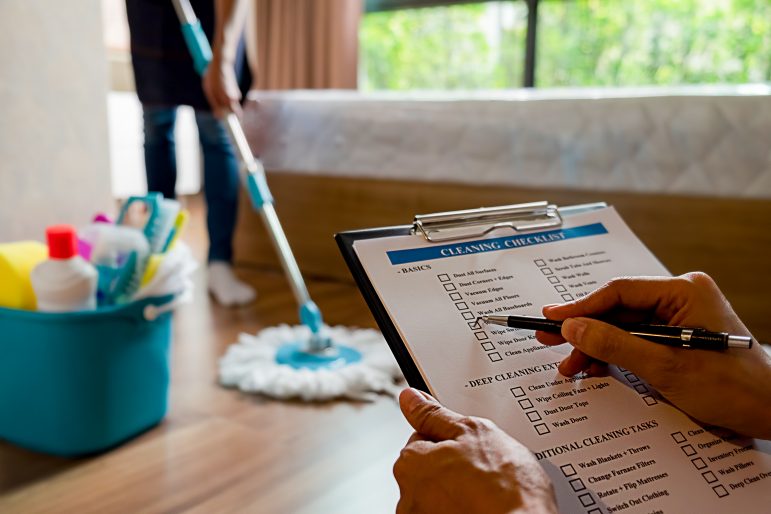Over the past two years, it’s no secret COVID-19 has posed unique challenges to long-term care facilities — and magnified the challenges they already face. Lack of funding, staffing shortages, and outbreak prevention are hot-button issues that will persist past the pandemic.
The question is: how can long-term care facilities tackle these challenges without adding additional labour and resources? The answer is by implementing more efficient and effective cleaning and hygiene tools, training, and procedures.
These key tips will help you design a specialized program that improves cleaning and hygiene while addressing the specific challenges faced in long-term care.
Challenge 1: Lack of funding
While long-term care facilities saw funding increase during the pandemic, underfunding is still an issue. That makes it even more critical to provide environmental staff with the necessary tools, training, and education to perform cleaning both efficiently and effectively.
Here is how to choose cleaning tools effectively:
- Work with your supplier to help ensure access to the supplies and tools best suited to your specific facility.
- Train environmental staff on performing cleaning tasks and procedures effectively to help improve all cleaning, from day-to-day to deep cleans. A combination of online, virtual, and in-person training sessions will help set your environmental staff up for success.
Challenge 2: Staffing shortages
While the demand for long-term care has increased, there has been a decline in the nursing workforce which has been exacerbated by the COVID-19 pandemic. Outbreaks hit facilities hard, and as of July 2020 48 per cent of long-term care homes in Ontario had declared at least one outbreak. This resulted in the sector peaking with 38 homes reporting critical staffing shortages in a variety of roles, due to issues that included staff contracting COVID-19, the fear of contracting COVID-19, and concern about accessing appropriate PPE.
With fewer staff members, finding inefficacies in cleaning procedures is critical to keeping facility residents and staff healthy and safe. With limited staff and resources, it’s critical to clean effectively without increasing cleaning time. The easiest way to clean more efficiently is to look for areas being over-cleaned. While cleaning effectiveness is critical, over-cleaning can lead to wasted time and resources.
Here are three key ways to avoid over-cleaning:
- Clean based on soil level: Soil level refers to the amount of dirt on a surface. More soiled surfaces will require more friction during cleaning to remove surface dirt, debris, and pathogens. Train environmental staff to focus efforts according to soil levels for more effective and efficient results.
- Focus on critical touchpoints: No matter the facility, people come into contact with high-touch surfaces numerous times a day. While keeping high-touch surfaces completely free from germs is not possible given their high frequency of use, regular cleaning and disinfecting is critical to minimize pathogens and the risk of disease outbreaks. Some examples of critical high-touchpoints include bed rails, bedside tables, overhead tables, call buttons, remote controls, and touchscreens.
- Leverage innovation: Innovative cleaning technology can help optimize resources and improve results. By looking to automation solutions and offloading repetitive cleaning tasks, environmental staff have more time to focus their efforts on more complex tasks. One area that can be easily offloaded is floor cleaning. Autonomous floor sweepers and scrubbers like the SC500 by Nilfisk help save time and money in cleaning routines. These machines automatically control water and detergent flow with the speed of the machine, ensuring that the cleaning solution is used efficiently and allowing large areas to be cleaned more cost-effectively.
Challenge 3: Outbreak prevention
Outbreak prevention is essential in long-term care. The average age in Ontario long-term care facilities is 83 years old, placing residents into the highest-risk category for illness. They are also more susceptible to complications from these illnesses, so outbreak prevention is a critical concern.
The best way to address outbreaks is to put proactive measures in place before they occur. These measures include promoting effective hand hygiene practices, performing proper cleaning and disinfecting, and effectively donning and doffing PPE.
While prioritizing proper cleaning is one thing, verifying and validating cleaning effectiveness is another. One way to track cleaning is through digital cleaning program management. These systems keep a log of cleaning activities in real-time to ensure that proper cleaning is being done, including tracking tasks that need to be performed multiple times a day such as high-touchpoint cleaning and disinfecting. They also have powerful reporting tools to help refine resource allocation and task scheduling to improve cleaning program performance and efficiency.
Digital cleaning program management systems help environmental staff:
- Verify cleaning compliance with established cleaning protocols
- Proactively clean areas based on specific traffic volume thresholds
- Track supply use and proactively replenish essential hygiene products based on automated alerts
- Validate cleaning quality and effectiveness through audit and reporting features
Software features and capabilities vary – some, such as the wandaNEXT™ software by Visionstate, include task lists, compliance reporting, scheduling heat maps, space utilization metrics, and more.
David L. Smith is the Cleaning, Hygiene & Sanitation Director at Bunzl Cleaning & Hygiene, Canada’s largest specialist distributor of cleaning and hygiene products and equipment. For more information or to book a comprehensive Facility Assessment please contact david.smith@bunzlch.ca.









